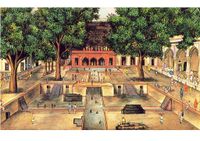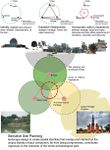Meharauli Archaeological Park - India
>>>Back to Case Studies Overview
>>>Add here a title for your case
| Name | Mehrauli Archaeological Park | |
| Place | New Delhi | |
| Country | India | |
| Author(s) | Amit Bhattacharya | |
| World Heritage | No(Qutab complex is only included in list) | |
|
| ||
Why is this case relevant?
- Mehrauli Archaeological Park, are scattered various monuments—a legacy of centuries of architectural skill. It is of prime historical value in the local, national, and international context.
The Mehrauli Archaeological Park covers 100 acres of green land abutting a World Heritage Site- the Qutb Minar. It is bound by the Chattarpur Road to the east and Qutb Complex in the north. This area is dotted with remains from every era of Delhi’s history—from the pre-Islamic to the late Mughal and the colonial period. The Tomar Rajputs established Lal Kot, the first fortification in Delhi here. The succeeding Chauhan rulers extended Lal Kot to form Qila Rai Pithora. In the late twelfth century Qutbuddin Aibak, the founder of the Delhi Sultanate, made this area the seat of Sultanate power. During the early Sultanate period several structures like tombs and mosques were built here. The trend of constructing monumental structures continued through the reign of successive rulers. Buildings like the mosque and tomb of Maulana Jamali (a sixteenth-century Sufi saint), Madhi Masjid, Rajon ki Baoli, and the tomb of Quli Khan (the foster brother of Emperor Akbar) were constructed within this area. Renovations like the extension of the Quli Khan Tomb into Thomas Metcalfe’s (commissioner of Delhi in the 1840s and 1850s) retreat and the conversion of the landscape through the addition of a bridge, canopies, and guesthouses were accomplished during the colonial era.
The Archaeological Park has a varied landform with irregular rocky slopes, valleys, plains, and water bodies. The park contains several water bodies, some of them manmade. These include Hauz-e-Shamsi,Rajon ki Baoli, Gandhak ki Baoli, Jharna, and the depression below the Quli Khan Tomb which earlier formed a pond. The park also contains a variety of vegetation and landscaped gardens such as Metcalfe’s Garden in front of Quli Khan’s Tomb. Today the park forms a buffer between the settlements at Mehrauli village and the Qutb complex and is one of the city’s largest green space.
Which idea of ‘design with nature’ guides the design concept of this site?
- In this section you talk about the design concept of your area. Is it a highly maintained site, i.e. does the design with nature require intensive maintenance? Or does the site follow a more organic interpretation of nature? Which changes are expected if maintenance is missing?
Which challenges is this landscape facing?
- Here you discuss the types of negative impact you are observing but you can also mention new functions that could give a development opportunity
What would be your strategy for improvement?
•Enhancing the promotion and recognition of the park •Enhancing the equipment and information infrastructure •An overall systematic reconstruction and development plan •Innovative restoration design •Sustainable management plan •Participatory and cognitive activities to attract citizen
Image Gallery
References
- Author Year: Title, publisher, edition, page, ...
- etc.
- Website Year: Link, keyword, ...
- etc.






